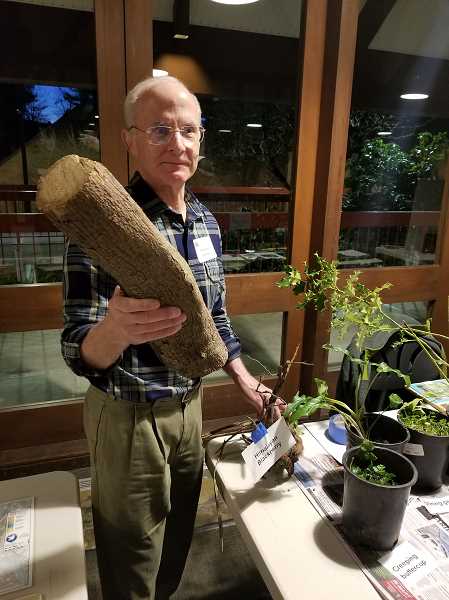
Council member Mike Buck displays invasive plants that have been removed during projects – that chunk of wood is an ivy vine! Photo: Anthony Macuk
Group’s membership and project scope have grown dramatically in just a few years.
Members of the Oswego Lake Watershed Council gathered Monday evening for the group’s second annual celebration event, offering visitors a chance to learn about its many projects from the past year.
Dateline: Thursday, Feb 8, 2018
Credit: Lake Oswego Review reporter Anthony Macuk
Original Article HERE.
The event at the Mountain Park clubhouse featured an array of display boards featuring different council projects and watershed groups. Several tables were run by “friends” groups established for city parks, including Hallinan, Springbrook and Iron Mountain. One of the biggest focus areas common to all the parks was invasive species removal.
At one display table, Jeff Lesh from the Clackamas County Soil and Water Conservation District offered visitors an overview of the various types of invasive species that tend to be common in Lake Oswego and the surrounding area, such as knotweed, garlic mustard and spurge laurel.
“The whole west hills has a problem with garlic mustard,” he said. “They just didn’t know how weedy it was going to be. It’s very hard to predict how weedy a plant will be in a new environment.”
At the Springbrook table, resident Paul Lyons recounted the story of the creation of the park. The land was originally clear-cut for fuel when Oswego was an iron mining town, and it was cleared again for lumber when the city began to transform into a residential area. But a pair of residents led a campaign in 1960 to have the City purchase and preserve the land as an urban forest.
At the Hallinan table, council members Jim and Barbara Fischer updated visitors on their progress in clearing ivy from a trio of parks: Hallinan, Freepons and the Cornell corridor of trees. And nearby, Sarah Ellison and other neighbors discussed an ongoing effort to add to the woods by purchasing an adjacent undeveloped private property that is currently fenced off.
Council member and Lake Oswego engineering staff member Rob Amsberry also operated a table, informing visitors about stormwater management practices and the geography of Oswego Lake’s watershed. Neighborhood restoration projects can often involve more than just the lake, he said, due to the proximity of the Willamette and Tualatin rivers. “Some of the projects they’re working on drain to the Willamette,” he said. “Mountain Park (for example) is a mix — they have three different watersheds they drain to.”
Watershed council volunteer coordinator Patrick Blanchard gave a presentation about the group’s 2017 efforts, which included projects at Mountain Park, Springbrook, Boutwell and Hallinan Woods, all made possible by dozens of volunteers at each project.
“We’re always trying to expand and grow bigger to make our impact greater,” he said. “This is not possible without all of you.”
Treasurer Thomas Bland also recounted the group’s growth — from around $300 in annual expenses to more than $50,000 in 2017, thanks to several grants received from the City of Lake Oswego and state organizations. Despite the administrative costs of the increasingly large organization, 95 percent of the funds still go directly to watershed work, he said.
Council Chair Stephanie Wagner handed out two awards intended to honor members for their contributions to the watershed. Council member Mike Buck was honored for his work removing invasive ivy throughout the city, and council member Dwight Sangrey was honored for his work on projects in Mountain Park in conjunction with the homeowners association.
Contact Lake Oswego Review reporter Anthony Macuk at 503-636-1281 or amacuk@lakeoswegoreview.com.
